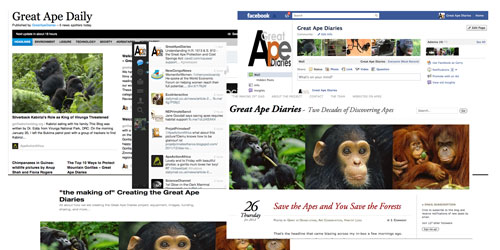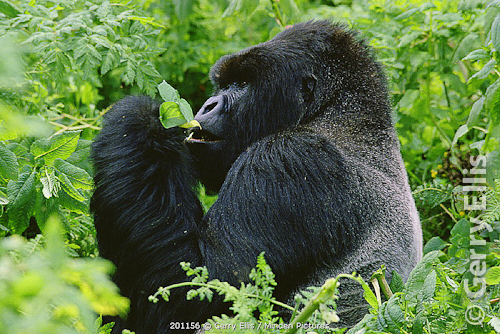January 13, 2012
The Top 10 Ways to Protect Mountain Gorillas
The recent popular YouTube video (
www.youtube.com/watch?v=hg2hCuDy2wg
showing a tourist being touched by wild mountain gorillas has captivated more than a million viewers and will likely inspire many travelers to book a trip to visit mountain gorillas themselves.
While the desire to connect intimately with one of our closest relatives is an innate reaction, such close contact with this endangered species is not in the best interest of their conservation. Disease transmission due to contact with humans is a very real problem for mountain gorillas, some of whom have become ill as a result of their proximity to humans. That said, tourism and the work of scientists, researchers, and other experts with gorillas are absolutely vital to the species’ survival.
For those looking to make a positive impact on mountain gorilla conservation, the Mountain Gorilla Veterinary Project would like to suggest 10 ways in which you can help:
1. Trek to see the mountain gorillas in Rwanda, DR Congo, or Uganda.
Without gorilla tourism, mountain gorillas might have gone extinct. The regions where mountain gorillas live are home to the densest human populations in Africa. Most of the people living in these areas are farmers, so land is critical to their livelihoods. However, the governments of Rwanda, Uganda, and DR Congo have kept the gorilla’s volcano habitat off-limits to agriculture in order to protect the gorillas, largely because the revenue gained through tourism outweighs the value of forested slopes for other purposes. Gorilla trekking permits are pricey ($400 in DR Congo and $500 in Rwanda and Uganda), but by purchasing permits, you’re not only buying a once-in-a-lifetime encounter with this charismatic species, you’re providing the economic incentive for the gorillas’ protection. Visit the tourism websites for gorilla trekking Rwanda (
http://www.rwandatourism.com/test/page.php?uri=Gorilla_Trekking), DR Congo (
www.visitvirunga.org), and Uganda (
http://www.ugandawildlife.org/gorilla-tracking-tourism-activity) to learn more.
2. Do not trek to see gorillas if you are sick.
Due to the genetic similarity between humans and mountain gorillas, gorillas are susceptible to many of the same infectious diseases that affect people. Mountain gorillas are also immunologically naïve, meaning they are particularly susceptible to human diseases because of their historic isolation from people. Research conducted by the Gorilla Doctors and other scientists has proven that mountain gorillas have died as a result of infections that originated in people. Infectious disease, after trauma, is the leading cause of death in mountain gorillas, accounting for 20% of acute mortality. The most common infection is respiratory disease, which can range from mild colds to severe pneumonia.
“To protect gorillas from such infections, the national park authorities ask that anyone feeling sick or running a fever to not trek gorillas.”
3. Stay at least 7 meters away from the gorillas.
In order to reduce the risk of disease transmission and to avoid changing or disturbing the gorillas’ natural behavior, the Gorilla Doctors have worked national park authorities to establish the rule of staying 7 meters (21 feet) or more from the gorillas at all times. The gorillas themselves, especially youngsters, don’t know the rules and may approach humans, but tourists should make the effort to back away and avoid touching the animal if possible. The 7-meter rule should be observed at all times, even when gorillas leave the national park and venture on to property owned by tourist lodges and camps.
4. Donate to conservation organizations working to protect mountain gorillas.
One of the most effective ways to help mountain gorillas is to donate money to organizations working on the ground to conserve the species. Numerous organizations including MGVP have spent decades finding effective methods for protecting mountain gorillas, and most rely on grants and donations to fund their work.
When donating your money to support any cause, it’s important to evaluate the organization you’re considering supporting to determine how successful the group is in carrying out its mission. You should find the answers to questions like, “What methods does the organization use to accomplish its stated goals?” and “Does the organization have any data or statistics to show that its methods are having an impact?” An organization’s website and annual reports should provide this information, or you can always send an inquiry to their public information or development officer.
MGVP is proud to be the only organization providing direct life-saving medical care to mountain gorillas in the wild. Research has shown that the work of the Gorilla Doctors and the anti-poaching efforts of the park rangers and trackers we work with is responsible for up to 40% of the growth of the human-habituated mountain gorilla population in the Virunga Massif over the last 10 years.
5. When visiting the region, do other activities in the parks in addition to gorilla trekking.
The vast majority of tourists who visit the national parks where gorillas live spend a day or two trekking gorillas and then leave. However, all of the gorilla parks offer other amazing wilderness experiences. As with gorilla trekking, the revenue earned through these activities further incentivizes the governments and local people to protect mountain gorilla habitat. You can climb the active Nyiragongo volcano in DR Congo, home to the world’s largest lava lake, or can climb extinct volcanoes in Rwanda and Uganda, such as the snow-covered Mt. Karismibi or the fluted peaks of Mt. Sabyinyo. Both Rwanda and Uganda offer treks to see golden monkeys (another highly endangered primate), and in Rwanda you may also visit the gravesite and former research station of Dian Fossey. Ask your tour provider about the options available.
6. Support local businesses and community projects around the national parks.
As much effort as the governments and conservation organizations put into protecting the gorillas, the support of the local people surrounding the parks is vital to ensure the preservation of gorilla habitat and the conservation of mountain gorillas. The more that local people share in tourism revenue and benefit from non-profit and community efforts in the area, the more likely they are to want to protect the mountain gorillas. Tourists can help by frequenting local restaurants, shops, and other businesses, or by making contributions to community projects around the park. For instance, tourists can pay to visit the Iby’Iwacu Cultural Village near Volcanoes National Park, Rwanda, which employs former poachers as cultural interpreters and performers.
7. Don’t buy products made with wild animal parts.
While mountain gorillas are very rarely targeted by poachers, other animals living in the national parks where gorillas live are actively hunted. Poachers mostly set snares to catch small antelopes to bring home to their families for food but occasionally larger animals such as buffalo or elephants may be targeted. Gorillas often get caught in poachers’ snares set for other animals. Furthermore, poachers’ very presence in the forest disturbs the environment and increases the risk of zoonotic disease transmission. While the main purpose of poaching is to obtain bush meat, wild animal skins, bones, and ivory may be used in crafts and other items sold to tourists. If you have any doubt about a product’s origins, don’t buy it. And certainly, in the rare instance you may see or hear of someone selling a live wild animal, report it to the national park authorities.
8 . Trek with a tour provider that donates a portion of the trip cost towards conservation efforts.
When researching tour packages to see gorillas, consider booking with a provider that directs a portion of their profits to support conservation projects. For example, Terra Incognita Ecotours, which offers 8-day Rwanda tours including a visit with the Gorilla Doctors, donates a portion of the trip cost to MGVP. In DR Congo, you can book packages including permits, transport, and accommodations directly through Virunga National Park, which puts profits right back into the park itself.
9. Organize a fundraiser.
Can’t afford to make significant personal donation or travel to Africa? Organize or participate in a fundraiser to help raise money for mountain gorilla conservation. In the past, schools have raised money for MGVP through bake sales and fun runs. Travelers and volunteers visiting gorillas in Rwanda have sold gorilla t-shirts to raise money to pay for their trips and make a donation to MGVP. One of biggest our fans even raised $30,000 in donations and pledges by walking 228 miles from Seattle to Portland, Oregon!
10. Spread the word about mountain gorilla conservation.
Anyone can make a difference for the gorillas by telling their friends, family, and colleagues about the mountain gorillas and the efforts being made to save them. Remember that even though mountain gorillas are critically endangered, their story is a positive one! Mountain gorillas are the only subspecies of non-human great ape growing in number. Fewer than 250 animals were counted in the mid-80s when Dian Fossey was researching the gorillas but today the population numbers nearly 800 animals. This species has a fighting chance for survival if we continue to work to address conservation challenges.
About Mountain Gorillas
With only 786 individuals left in the world, mountain gorillas are a critically endangered population. Mountain gorillas live in central Africa, with about 480 animals living in the 173-square-mile Virunga Volcanoes Massif, which combines Volcanoes National Park in Rwanda, Virunga National Park in the Democratic Republic of Congo, and Mgahinga National Park in Uganda. The remaining population lives within the boundaries of the 128-square-mile Bwindi Impenetrable National Park in Uganda.
About the Mountain Gorilla Veterinary Project
The Mountain Gorilla Veterinary Project, a U.S.-based nonprofit organization, is dedicated to saving mountain gorilla lives. With so few animals left in the world today, the organization believes it is critical to ensure the health and well being of every individual possible. The organization’s international team of veterinarians, the Gorilla Doctors, is the only group providing wild mountain gorillas with direct, hands-on care. The Mountain Gorilla Veterinary Project partners with the UC Davis Wildlife Health Center to advance One Health strategies for mountain gorilla conservation.www.gorilladoctors.org
About the UC Davis Wildlife Health Center
The UC Davis Wildlife Health Center, home of the Mountain Gorilla One Health Program and a center of excellence within the School of Veterinary Medicine, is composed of 13 epidemiologists, disease ecologists and ecosystem health clinicians and their staff working at the cutting edge of pathogen emergence and disease tracking in ecosystems. It benefits from the expertise of 50 other participating UC Davis faculty members from many disciplines who are involved in the discovery and synthesis of information about emerging zoonotic diseases (those transmitted between people and animals) and ecosystem health. Its mission is to balance the needs of people, wildlife and the environment through research, education and service. www.vetmed.ucdavis.edu/whc.








